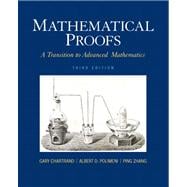
Note: Supplemental materials are not guaranteed with Rental or Used book purchases.
Purchase Benefits
What is included with this book?
0. Communicating Mathematics
Learning Mathematics
What Others Have Said About Writing
Mathematical Writing
Using Symbols
Writing Mathematical Expressions
Common Words and Phrases in Mathematics
Some Closing Comments About Writing
1. Sets
1.1. Describing a Set
1.2. Subsets
1.3. Set Operations
1.4. Indexed Collections of Sets
1.5. Partitions of Sets
1.6. Cartesian Products of Sets
Exercises for Chapter 1
2. Logic
2.1. Statements
2.2. The Negation of a Statement
2.3. The Disjunction and Conjunction of Statements
2.4. The Implication
2.5. More On Implications
2.6. The Biconditional
2.7. Tautologies and Contradictions
2.8. Logical Equivalence
2.9. Some Fundamental Properties of Logical Equivalence
2.10. Quantified Statements
2.11. Characterizations of Statements
Exercises for Chapter 2
3. Direct Proof and Proof by Contrapositive
3.1. Trivial and Vacuous Proofs
3.2. Direct Proofs
3.3. Proof by Contrapositive
3.4. Proof by Cases
3.5. Proof Evaluations
Exercises for Chapter 3
4. More on Direct Proof and Proof by Contrapositive
4.1. Proofs Involving Divisibility of Integers
4.2. Proofs Involving Congruence of Integers
4.3. Proofs Involving Real Numbers
4.4. Proofs Involving Sets
4.5. Fundamental Properties of Set Operations
4.6. Proofs Involving Cartesian Products of Sets
Exercises for Chapter 4
5. Existence and Proof by Contradiction
5.1. Counterexamples
5.2. Proof by Contradiction
5.3. A Review of Three Proof Techniques
5.4. Existence Proofs
5.5. Disproving Existence Statements
Exercises for Chapter 5
6. Mathematical Induction
6.1 The Principle of Mathematical Induction
6.2 A More General Principle of Mathematical Induction
6.3 Proof By Minimum Counterexample
6.4 The Strong Principle of Mathematical Induction
Exercises for Chapter 6
7. Prove or Disprove
7.1 Conjectures in Mathematics
7.2 Revisiting Quantified Statements
7.3 Testing Statements
Exercises for Chapter 7
8. Equivalence Relations
8.1 Relations
8.2 Properties of Relations
8.3 Equivalence Relations
8.4 Properties of Equivalence Classes
8.5 Congruence Modulo n
8.6 The Integers Modulo n
Exercises for Chapter 8
9. Functions
9.1 The Definition of Function
9.2 The Set of All Functions from A to B
9.3 One-to-one and Onto Functions
9.4 Bijective Functions
9.5 Composition of Functions
9.6 Inverse Functions
9.7 Permutations
Exercises for Chapter 9
10. Cardinalities of Sets
10.1 Numerically Equivalent Sets
10.2 Denumerable Sets
10.3 Uncountable Sets
10.4 Comparing Cardinalities of Sets
10.5 The Schröder-Bernstein Theorem
Exercises for Chapter 10
11. Proofs in Number Theory
11.1 Divisibility Properties of Integers
11.2 The Division Algorithm
11.3 Greatest Common Divisors
11.4 The Euclidean Algorithm
11.5 Relatively Prime Integers
11.6 The Fundamental Theorem of Arithmetic
11.7 Concepts Involving Sums of Divisors
Exercises for Chapter 11
12. Proofs in Calculus
12.1 Limits of Sequences
12.2 Infinite Series
12.3 Limits of Functions
12.4 Fundamental Properties of Limits of Functions
12.5 Continuity
12.6 Differentiability
Exercises for Chapter 12
13. Proofs in Group Theory
13.1 Binary Operations
13.2 Groups
13.3 Permutation Groups
13.4 Fundamental Properties of Groups
13.5 Subgroups
13.6 Isomorphic Groups
Exercises for Chapter 13
14. Proofs in Ring Theory (Online)
14.1 Rings
14.2 Elementary Properties of Rings
14.3 Subrings
14.4 Integral Domains
14.5 Fields
Exercises for Chapter 14
15. Proofs in Linear Algebra (Online)
15.1 Properties of Vectors in 3-Space
15.2 Vector Spaces
15.3 Matrices
15.4 Some Properties of Vector Spaces
15.5 Subspaces
15.6 Spans of Vectors
15.7 Linear Dependence and Independence
15.8 Linear Transformations
15.9 Properties of Linear Transformations
Exercises for Chapter 15
16. Proofs in Topology (Online)
16.1 Metric Spaces
16.2 Open Sets in Metric Spaces
16.3 Continuity in Metric Spaces
16.4 Topological Spaces
16.5 Continuity in Topological Spaces
Exercises for Chapter 16
Answers and Hints to Odd-Numbered Section Exercises
References
Index of Symbols
Index of Mathematical Terms
The New copy of this book will include any supplemental materials advertised. Please check the title of the book to determine if it should include any access cards, study guides, lab manuals, CDs, etc.
The Used, Rental and eBook copies of this book are not guaranteed to include any supplemental materials. Typically, only the book itself is included. This is true even if the title states it includes any access cards, study guides, lab manuals, CDs, etc.